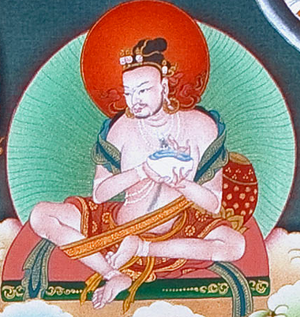Six Yogas of Naropa: Difference between revisions
Jump to navigation
Jump to search
m (1 revision: moved all 6-Six to 06-Six) |
No edit summary |
(No difference)
| |
Revision as of 10:53, 16 March 2011

The Six Yogas (or, more literally, Dharmas) of Naropa (Wyl. na ro chos drug), sometimes also referred to simply as the Six Yogas (Wyl. chos drug), are six sets of teachings and practices which originate from the Indian mahasiddha Naropa. They form the basis of the inner yoga practices of Mahamudra, as practised in the Kagyü and Gelug schools. They are:
- Inner heat (Tib. tummo; Wyl. gtum mo) which is the root of the path. For a dzogrim practitioner this meditation on inner heat is like the root of the entire path. Without some experience of tummo practice, it is said, the various experiences (Tib. nyam) of tsa-lung practice such as bliss, clarity and absence of thought will not arise.
- Illusory body (Tib. gyu lü; Wyl. sgyu lus) which is the foundation of the path.
- Clear light/luminosity (Tib. ösal; Wyl. 'od gsal) which is the heart-essence of the path.
- Then in order to test the strength of, or assess one's progress in, the practice of clear light, there is the dream yoga (Wyl. rmi lam).
- For those who are unable to complete the practice of clear light because untimely death occurs, there needs to be one who picks them up, just as when one is travelling to a country such as France and one needs to be picked up at the airport. The practice which comes to 'collect' you is the practice of phowa (Wyl. 'pho ba).
- Then, finally, the juncture which bridges the gap between past and future lives and provides a connection with the Zangdokpalri heaven of Guru Rinpoche or the pure realms such as Sukhavati (Tib. Dewachen), is the bardo. By applying the bardo teachings a practitioner whose practice isn't particularly great can transform their practice and become a great practitioner.
Further Reading
- Garma C.C. Chang, The Six Yogas of Naropa, Snow Lion, 1986